Table of content
Introduction
Soybean sprouts, often overlooked in Western kitchens, are a culinary gem celebrated for their crisp texture, mild nutty flavor, and impressive nutritional profile. These versatile vegetables, known as kongnamul in Korean cuisine and douya in Chinese, can transform a simple meal into a flavorful feast when cooked correctly. Whether you’re a seasoned home cook or a novice in the kitchen, mastering the art of stir-frying soybean sprouts opens doors to endless possibilities—from zesty side dishes to hearty main courses. This article delves into the secrets of selecting, preparing, and cooking soybean sprouts to perfection, ensuring every bite bursts with satisfying crunch and savory depth.
Chapter 1: Understanding Soybean Sprouts
Before diving into recipes, it’s essential to grasp what makes soybean sprouts unique. Unlike their thinner, more delicate mung bean counterparts, soybean sprouts boast a sturdier build, with a plump yellow body and a small, tender green leaf at one end. Their robust texture allows them to withstand high-heat cooking methods like stir-frying without turning mushy, making them ideal for quick, vibrant dishes.
Nutritional Powerhouse
Soybean sprouts are not just delicious—they’re a nutritional powerhouse. Packed with protein, fiber, vitamins C and K, and antioxidants, they offer a low-calorie, nutrient-dense addition to any meal. Their high fiber content aids digestion, while their protein makes them a valuable plant-based ingredient for vegans and vegetarians.
Culinary Versatility
From soups and salads to stir-fries and pickles, soybean sprouts adapt effortlessly to various cuisines. Their ability to absorb flavors while retaining their crunch makes them a favorite in Asian cooking, but their charm extends far beyond traditional recipes.
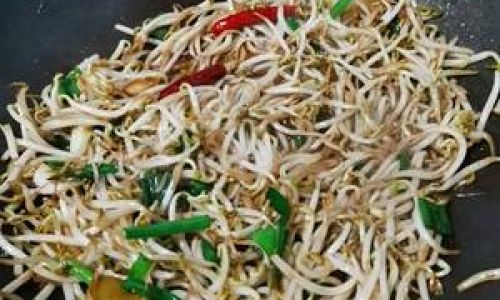
Chapter 2: Selecting and Storing Soybean Sprouts
The journey to a perfect dish begins at the grocery store or farmers’ market. Here’s how to choose and store soybean sprouts for optimal freshness:
- Appearance: Look for sprouts with firm, ivory-white stems and vibrant green leaves. Avoid those with wilted leaves, slimy textures, or brown spots—signs of spoilage.
- Smell: Fresh soybean sprouts should have a clean, earthy aroma. A sour or musty scent indicates they’re past their prime.
- Storage: If not using immediately, store unwashed sprouts in a breathable bag in the refrigerator’s crisper drawer. Use within 3–5 days for peak flavor.
Chapter 3: Preparation Techniques
Proper preparation is the cornerstone of a great stir-fry. Follow these steps to ensure your soybean sprouts are clean, trimmed, and ready to cook:
- Rinsing: Place the sprouts in a large bowl of cold water. Gently swish them to dislodge dirt or debris. Drain and repeat until the water runs clear.
- Trimming: Use a sharp knife to snip off the stringy root ends. While time-consuming, this step enhances texture and prevents bitterness.
- Drying: Pat the sprouts dry with a clean kitchen towel or use a salad spinner. Excess moisture can turn your stir-fry soggy.
Chapter 4: The Science of Stir-Frying
Stir-frying is a high-heat cooking method that sears ingredients quickly, preserving their texture and nutrients. To achieve restaurant-quality results, master these techniques:
- Wok or Skillet: A carbon-steel wok is ideal for even heat distribution, but a large stainless-steel or cast-iron skillet works well too.
- Heat Control: Preheat your pan over medium-high to high heat until a drop of water evaporates instantly. This “sear” ensures your sprouts cook rapidly without steaming.
- Oil Selection: Use an oil with a high smoke point, like peanut, canola, or avocado oil. Avoid olive oil, which can burn at high temperatures.
- Aromatics First: Sauté garlic, ginger, or chili in hot oil for 30 seconds to release their flavors before adding the sprouts.
- Stir Constantly: Use a spatula or tongs to toss the sprouts continuously, ensuring even cooking.
Chapter 5: Flavor Pairings and Seasonings
The beauty of soybean sprouts lies in their ability to harmonize with diverse flavors. Experiment with these combinations to elevate your dishes:
- Umami Boosters: Soy sauce, oyster sauce, or fish sauce add savory depth.
- Aromatics: Garlic, ginger, scallions, and shallots build a fragrant base.
- Heat: Fresh chili, gochugaru (Korean red pepper flakes), or sriracha introduce a spicy kick.
- Freshness: Cilantro, basil, or lime zest brighten the dish.
- Nuttiness: Toasted sesame oil or seeds add a rich finish.
Chapter 6: Recipes to Try
Recipe 1: Spicy Soybean Sprout Stir-Fry (Kongnamul Muchim)
Ingredients:
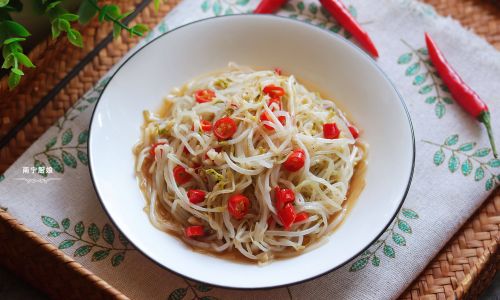
- 1 lb fresh soybean sprouts
- 2 tbsp vegetable oil
- 3 garlic cloves, minced
- 1 tbsp gochugaru (adjust to taste)
- 1 tbsp soy sauce
- 1 tsp sesame oil
- 1 tsp sugar
- 1 tsp rice vinegar
- 2 green onions, sliced
- 1 tbsp toasted sesame seeds
Instructions:
- Heat oil in a wok over high heat. Add garlic and gochugaru; stir-fry for 30 seconds.
- Toss in soybean sprouts and stir-fry for 3–4 minutes until slightly wilted.
- Drizzle with soy sauce, sesame oil, sugar, and vinegar. Toss to coat.
- Remove from heat. Garnish with green onions and sesame seeds. Serve immediately.
Recipe 2: Garlic-Butter Soybean Sprouts
Ingredients:
- 1 lb soybean sprouts
- 3 tbsp unsalted butter
- 4 garlic cloves, thinly sliced
- 1 tsp red pepper flakes
- 1 tbsp lemon juice
- Salt and pepper to taste
- 2 tbsp chopped parsley
Instructions:
- Melt butter in a large skillet over medium-high heat. Add garlic and red pepper flakes; sauté until fragrant (1 minute).
- Increase heat to high. Add soybean sprouts and stir-fry for 4–5 minutes until tender-crisp.
- Squeeze lemon juice over the sprouts. Season with salt and pepper.
- Sprinkle with parsley and serve hot.
Chapter 7: Common Mistakes to Avoid
Even seasoned cooks stumble occasionally. Steer clear of these pitfalls:
- Overcooking: Soybean sprouts should retain some crunch. Cook until just tender (3–5 minutes).
- Crowding the Pan: Overcrowding lowers the pan’s temperature, leading to steaming instead of searing. Cook in batches if needed.
- Skipping Aromatics: Garlic and ginger are flavor foundations—don’t omit them!
- Underseasoning: Taste and adjust seasoning before serving. A splash of soy sauce or lemon juice can brighten the dish.
Chapter 8: Beyond Stir-Frying
Soybean sprouts aren’t limited to stir-fries. Explore these alternative cooking methods:
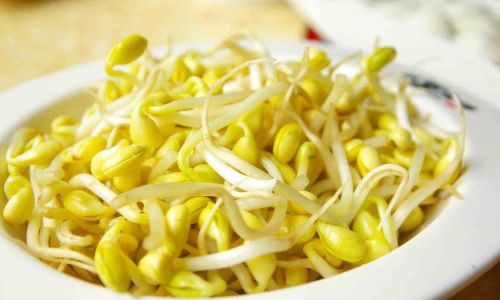
- Boiling: Simmer sprouts in salted water for 2–3 minutes. Drain and toss with sesame oil and soy sauce.
- Soups: Add to miso soup or hot pot during the final minutes of cooking.
- Salads: Blanch sprouts briefly, then toss with herbs, nuts, and a tangy vinaigrette.
- Pickling: Ferment sprouts in a brine with chili and garlic for a probiotic-rich side dish.
Chapter 9: Health Benefits and Dietary Adaptations
Soybean sprouts cater to various dietary needs:
- Vegan/Vegetarian: Pair with tofu or tempeh for a protein-packed meal.
- Gluten-Free: Use tamari instead of soy sauce.
- Low-Carb: Serve as a crunchy substitute for noodles or rice.
Chapter 10: Cultural Significance
In Korean cuisine, soybean sprouts are a staple in bibimbap (mixed rice bowls) and kongnamul-guk (sprout soup). Chinese chefs often incorporate them into mapo tofu or hot pot, while Vietnamese cooks use them in bun cha (grilled pork noodles). Understanding these traditions adds depth to your cooking and appreciation for the ingredient’s versatility.
Conclusion
Cooking soybean sprouts to perfection is an art that balances technique, creativity, and respect for the ingredient’s natural qualities. By selecting fresh sprouts, mastering stir-frying basics, and experimenting with flavors, you can elevate this humble vegetable into a star ingredient. Whether you prefer fiery spice, buttery garlic, or tangy freshness, soybean sprouts reward every culinary adventure with their satisfying crunch and adaptability. So grab your wok, fire up the stove, and let the humble soybean sprout transform your kitchen into a stage for global flavors.



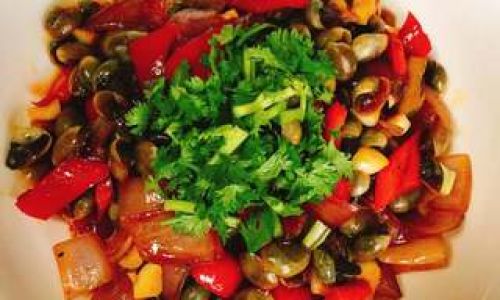

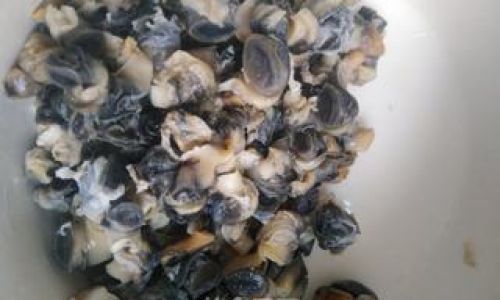
0 comments